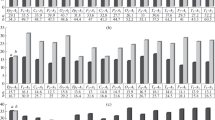Abstract
This paper presents the results of experimental studies of the dynamics of the functional state of a person within the zone of an active geological fault characterized by abnormal spatial distribution of the magnetic- field vector values. It is shown that these geophysical modifications have a pronounced effect on the fluctuations of the electrical activity of the human brain. When the person gets into a zone with abnormal levels of gradient magnetic field in the absence of any subjective sensations, a nonspecific orientation activation reaction is observed, which is characterized by a significant increase in the levels of peak performance in key functional EEG frequency bands.
Similar content being viewed by others
References
Belov, D.R., Kanunikov, I.E., and Kiselev, B.V., Dependence of human EEG spatial synchronization on the geomagnetic activity on the day of experiment, Ross. Fiziol. Zh. im. I. M. Sechenova, 1998, vol. 84, no. 8, pp. 761–773.
Belov, D.R., Getmanenko, O.V., and Kiselev, B.V., Twophase response of human higher nervous system to geomagnetic storms according to EEG data, Ross. Fiziol. Zh. im. I. M. Sechenova, 2001, vol. 87, no. 3, pp. 296–313.
Bistolfi, F., Extremely low-frequency pulsed magnetic field sand multiple sclerosis: Effects on neurotransmissional alone or also on immunomodulation? Building a working hypothesis, Neuroradiol. J., 2007, vol. 20, no. 6, pp. 676–693.
Breus, T.K., Chibisov, S.M., and Baevskii, R.M., Khronostruktura bioritmov serdtsa i faktory vneshnei sredy (Chronostructure of Heart Biorhythms and External Environmental Factors), Moscow: Poligraf servis, 2002.
Chernykh, A.M., El’kin, A.I., and Pozdeev, V.N., Ecological threat for human health during the electrical and anomalous geomagnetic fields’ influence: Review of the literature, Voen.-Med. Zh., 2005, vol. 326, no. 6, pp. 46–50.
Dennis, T.E., Rayner, M.J., and Walker, M.M., Evidence that pigeons orient to geomagnetic intensity during homing, Proc. Biol. Sci., 2007, vol. 274, no. 7, pp. 1153–1158.
Dubrov, A.P., Geomagnitnoe pole i zhizn’: Kratkii ocherk po geomagnitobiologii (Geomagnetic Field and Life: A Brief Sketch of Geomagnetic Biology), Leningrad: Gidrometeoizdat, 1974.
Erofeev, L.Ya., The structure of the magnetic field of the Darsunsky gold mine (Zabaikal’e), Izv. Tomsk. Politekhn. Inst., 1976, vol. 236, pp. 24–29.
Geodakov, A.R., Ovsyuchenko, A.N., Platonova, S.G., and Rogozhin, E.A., Materialy predvaritel’nogo izucheniya sil’nogo zemletryaseniya 2003 g. na Gornom Altae, Vestn. Otd. Nauk Zemle RAN, 2003, no. 1, pp. 1–22.
Gnezditskii, V.V., Obratnaya zadacha EEG i klinicheskaya elektroentsefalografiya (kartirovanie i lokalizatsiya istochnikov elektricheskoi aktivnosti mozga) (The Inverse Problem of EEG and Clinical Electroencephalography (Mapping and Localization of Brain Electric Activity Sources)), Moscow: MEDpress-inform, 2004.
Kolesnik, A.G., Kolesnik, S.A., and Pobachenko, S.V., Elektromagnitnaya ekologiya (Electromagnetic Ecology), Tomsk: TML-press, 2009.
Liboff, A.R., Why are living things sensitive to weak magnetic fields?, Electromagn. Biol. Med., 2013, vol. 33, no. 3, pp. 241–245. doi 10.3109/15368378.2013.809579
Mach, Q.H. and Persinger, M.A., Behavioral changes with brief exposures to weak magnetic fields patterned to stimulate long-term potentiation, Brain Res., 2009, vol. 1261, pp. 45–53.
Magnitorazvedka: Spravochnik geofizika (Magnetic Survey: Handbook of Geophysicists), Nikitskii, V.E. and Glebovskii, Yu.S., Eds., Moscow: Nedra, 1980.
Oraevskii, V.N., Breus, T.K., Baevskii, R.M., Rapoport, S.I., Petrov, V.M., Barsukova, Zh.V., Gurfinkel, Yu.I., and Rogoza, A.T., Geomagnetic activity effects on the functional characteristics of the human organism, Biophysics, 1998, vol. 43, no. 5, pp. 776–782.
Pobachenko, S.V., Kolesnik, A.G., Borodin, A.S., and Kalyuzhin, V.V., The contingency of parameters of human encephalograms and Schumann resonance electromagnetic fields revealed in monitoring studies, Biophysics, 2006, vol. 51, no. 3, pp. 480–483.
Shitov, A.V., Tuzhilkin, D.A., Borodin, A.S., and Apryatkina, M.G., Influence of physical fields on active geological fault lines on human cardiovascular system, Geofiz. Protsessy Biosfera, 2013, vol. 12, no. 3, pp. 55–77.
Timofeev, V.Yu., Ardyukov, D.G., Kale, E., Duchkov, A.D., Zapreeva, E.A., Kazantsev, S.A., Rusbek, F., and Bryuniks, K., Fields and models the Earth’s surface shifts in Mountainous Altai, Geol. Geofiz., 2006, vol. 47, no. 8, pp. 923–927.
Vladimirskii, B.M., Solnechnaya aktivnost’ i obshchestvennaya zhizn’. Kosmicheskaya istoriometriya: ot pervykh rossiiskikh kosmistov do nashikh dnei (Solar Activity and Social Life. Cosmic Historiometry: From First Russian Cosmists to Present Days), Moscow: Librokom, 2013.
Walker, M.M. and Bitterman, M.E., Honey bees can be trained to respond to very small change singeomagnetic field intensity, J. Exp. Biol., 1989, vol. 145, pp. 489–494.
Wiltschko, R., Schiffner, I., and Wiltschko, W., A strong magnetic anomaly affects pigeon navigation, J. Exp. Biol., 2009, vol. 212, pp. 2983–2990.
Zabroda, N.N. and Artemenko, M.V., Hygienic characteristics of the Kursk magnetic anomaly area and morbidity in the aboriginal population, Gig. Sanit., 2008, no. 5, pp. 35–38.
Author information
Authors and Affiliations
Corresponding author
Additional information
Original Russian Text © S.V. Pobachenko, A.V. Shitov, P.E. Grigorjev, M.V. Sokolov, A.I. Zubrilkin, D.N. Vypiraylo, A.V. Solovjev, 2015, published in Geofizicheskie Protsessy i Biosfera, 2015, Vol. 14, No. 4, pp. 37–48.
Rights and permissions
About this article
Cite this article
Pobachenko, S.V., Shitov, A.V., Grigorjev, P.E. et al. EEG reactions of the human brain in the gradient magnetic field zone of the active geological fault (pilot study). Izv. Atmos. Ocean. Phys. 52, 745–752 (2016). https://doi.org/10.1134/S0001433816070057
Published:
Issue Date:
DOI: https://doi.org/10.1134/S0001433816070057




